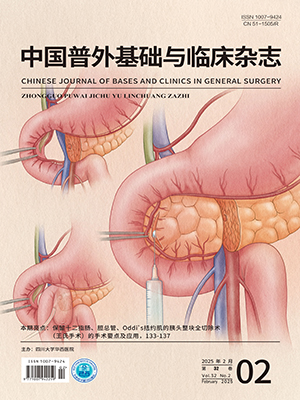| 1. |
李雅睿, 任牡丹, 卢桂芳, 等. 多聚嘧啶区结合蛋白1对胃癌细胞增殖和转移的作用机制. 中华消化杂志, 2021, 41(2): 100-106.
|
| 2. |
Venerito M, Link A, Rokkas T, et al. Gastric cancer - clinical and epidemiological aspects. Helicobacter, 2016, 21 Suppl 1: 39-44.
|
| 3. |
王健力, 俞泽元, 苏阿德, 等. TRIM21在胃癌诊断和预后中的价值. 中国普外基础与临床杂志, 2021, 28(1): 33-37.
|
| 4. |
赵琪, 何长海, 王志, 等. 敲低ALKBH3对膀胱癌细胞生长、迁移与肿瘤血管生成的抑制作用及其机制. 吉林大学学报 (医学版), 2021, 47(2): 397-406.
|
| 5. |
Tian S, Peng P, Li J, et al. SERPINH1 regulates EMT and gastric cancer metastasis via the Wnt/β-catenin signaling pathway. Aging (Albany NY), 2020, 12(4): 3574-3593.
|
| 6. |
程乐达, 程鹏, 杨雄飞, 等. 肿瘤外泌体来源的miR-126-5p通过抑制NLRC3促进口腔鳞癌细胞的增殖和迁移. 重庆医学, 2021, 50(8): 1284-1288.
|
| 7. |
Cai W, Xu Y, Yin J, et al. miR-552-5p facilitates osteosarcoma cell proliferation and metastasis by targeting WIF1. Exp Ther Med, 2019, 17(5): 3781-3788.
|
| 8. |
Gu J, Han T, Sun L, et al. miR-552 promotes laryngocarcinoma cells proliferation and metastasis by targeting p53 pathway. Cell Cycle, 2020, 19(9): 1012-1021.
|
| 9. |
Feng X, Zhu M, Liao B, et al. Upregulation of miR-552 predicts unfavorable prognosis of gastric cancer and promotes the proliferation, migration, and invasion of gastric cancer cells. Oncol Res Treat, 2020, 43(3): 103-111.
|
| 10. |
Kim J, Bae DH, Kim JH, et al. HOXC10 overexpression promotes cell proliferation and migration in gastric cancer. Oncol Rep, 2019, 42(1): 202-212.
|
| 11. |
Qu W, Wen X, Su K, et al. MiR-552 promotes the proliferation, migration and EMT of hepatocellular carcinoma cells by inhibiting AJAP1 expression. J Cell Mol Med, 2019, 23(2): 1541-1552.
|
| 12. |
黄修燕, 黄自丽, 许永华, 等. 肝癌外泌体环状RNA-100338对血管内皮细胞成管能力的影响. 中华实验外科杂志, 2020, 37(1): 40-43.
|
| 13. |
Kok VC, Yu CC. Cancer-derived exosomes: Their role in cancer biology and biomarker development. Int J Nanomedicine, 2020, 15(1): 8019-8036.
|
| 14. |
Du J, Liang Y, Li J, et al. Gastric cancer cell-derived exosomal microRNA-23a promotes angiogenesis by targeting PTEN. Front Oncol, 2020, 10(1): 326-339.
|
| 15. |
Wei S, Peng L, Yang J, et al. Exosomal transfer of miR-15b-3p enhances tumorigenesis and malignant transformation through the DYNLT1/Caspase-3/Caspase-9 signaling pathway in gastric cancer. J Exp Clin Cancer Res, 2020, 39(1): 32-50.
|
| 16. |
Shen Y, Xue C, Li X, et al. Effects of gastric cancer cell-derived exosomes on the immune regulation of mesenchymal stem cells by the NF-kB signaling pathway. Stem Cells Dev, 2019, 28(7): 464-476.
|
| 17. |
Bai M, Li J, Yang H, et al. miR-135b Delivered by Gastric Tumor Exosomes Inhibits FOXO1 Expression in Endothelial Cells and Promotes Angiogenesis. Mol Ther, 2019, 27(10): 1772-1783.
|
| 18. |
Qi R, Wang DT, Xing LF, et al. miRNA-21 promotes gastric cancer growth by adjusting prostaglandin E2. Eur Rev Med Pharmacol Sci, 2018, 22(7): 1929-1936.
|
| 19. |
陈莉, 徐惠丽, 王梦漪, 等. miRNA-424-5p靶向SIRT4促进胃癌细胞迁移和侵袭的分子机制. 实用医学杂志, 2020, 36(8): 1022-1029.
|
| 20. |
Li Q, Li B, Li Q, et al. Exosomal miR-21-5p derived from gastric cancer promotes peritoneal metastasis via mesothelial-to-mesenchymal transition. Cell Death Dis, 2018, 9(9): 854-871.
|
| 21. |
Zhao W, Han T, Li B, et al. miR-552 promotes ovarian cancer progression by regulating PTEN pathway. J Ovarian Res, 2019, 12(1): 121-131.
|
| 22. |
Ma Y, Ma M, Ma L, et al. Downregulation of miR-552 in hepatocellular carcinoma inhibits cell migration and invasion, and promotes cell apoptosis via RUNX3. Exp Ther Med, 2019, 18(5): 3829-3836.
|
| 23. |
Wang N, Liu W. Increased expression of miR-552 acts as a potential predictor biomarker for poor prognosis of colorectal cancer. Eur Rev Med Pharmacol Sci, 2018, 22(2): 412-416.
|
| 24. |
Zhao Y, Zhang J, Yang W, et al. MicroRNA-552 accelerates the progression of gastric cancer by targeting FOXO1 and regulating PI3K/AKT pathway. J Oncol, 2021, 2021: 9966744. doi: 10.1155/2021/9966744.
|
| 25. |
洪嵩, 蔡东峰, 张靖, 等. miR-552靶向调控Wnt抑制因子-1促进MG-63骨肉瘤细胞增殖、侵袭、迁移的实验研究. 临床肿瘤学杂志, 2019, 24(6): 494-499.
|




